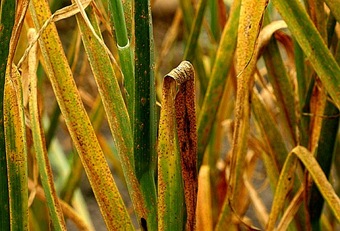 Leaf rust is typically associated with alliums. Leeks, onions, shallots and chives are affected, but on our allotment site it seems particularly prevalent in garlic. It’s worth noting that rust is believed to be species specific, so you might note that where garlic or leeks have been affected, the shallots and onions were mercifully untouched. Whereas leek varieties such as ‘Neptune’ are resistant to rust, resistant garlic lines have yet to be identified. So here are a few notes which may prove useful in understanding and managing rust infections:
Leaf rust is typically associated with alliums. Leeks, onions, shallots and chives are affected, but on our allotment site it seems particularly prevalent in garlic. It’s worth noting that rust is believed to be species specific, so you might note that where garlic or leeks have been affected, the shallots and onions were mercifully untouched. Whereas leek varieties such as ‘Neptune’ are resistant to rust, resistant garlic lines have yet to be identified. So here are a few notes which may prove useful in understanding and managing rust infections:
Cause
- Rust infection is promoted by low light and high moisture levels
- This fungus may over-winter on dead plant material, in the soil, or on wild ‘hosts’
- Severe losses are likely when excessive rain, fog, or irrigation are present
- Highest infection rates occur at cool temperatures (10-15ºC) and 100% relative humidity
- Ambient temperatures below 10° C and above 24° C inhibit the disease
- Plants stressed by too much or too little water have been shown to be more susceptible to damage from rust.
Symptoms
- Initial symptoms may range between small white-yellow flecks and spots
- Heavily infected plants have an orange ‘cast’. Reddish-orange spots appear on leaves, sheaths and stems
- Outer leaves may yellow and wither prematurely
- Bulb size may be reduced. Garlic is normally harvested when tops begin to die down around July – August, but rust typically strikes towards the end of June- early July and thus inhibits the development of the crop
Cultural control
- Try to avoid shade and maintain an appropriate watering regime
- Exclude Allium crops from the rotational cycle of infected beds for 2-3 years; keep these beds weed-free and remove any dead pant material. the aim of this being to ensure the life-cycle of the disease cannot be perpetuated
- Destroy (burn ) all volunteers and Allium weeds (may be host plants). Do not compost any affected plants!
- Use clean (bought, not saved) seed
Chemical control
- Apply sulphate of potash at a rate of 20/25g per sq/mtr. This helps harden plant tissues and improves resistance
- Infected plants should be treated immediately by spraying with an appropriate fungicide


No comments:
Post a Comment